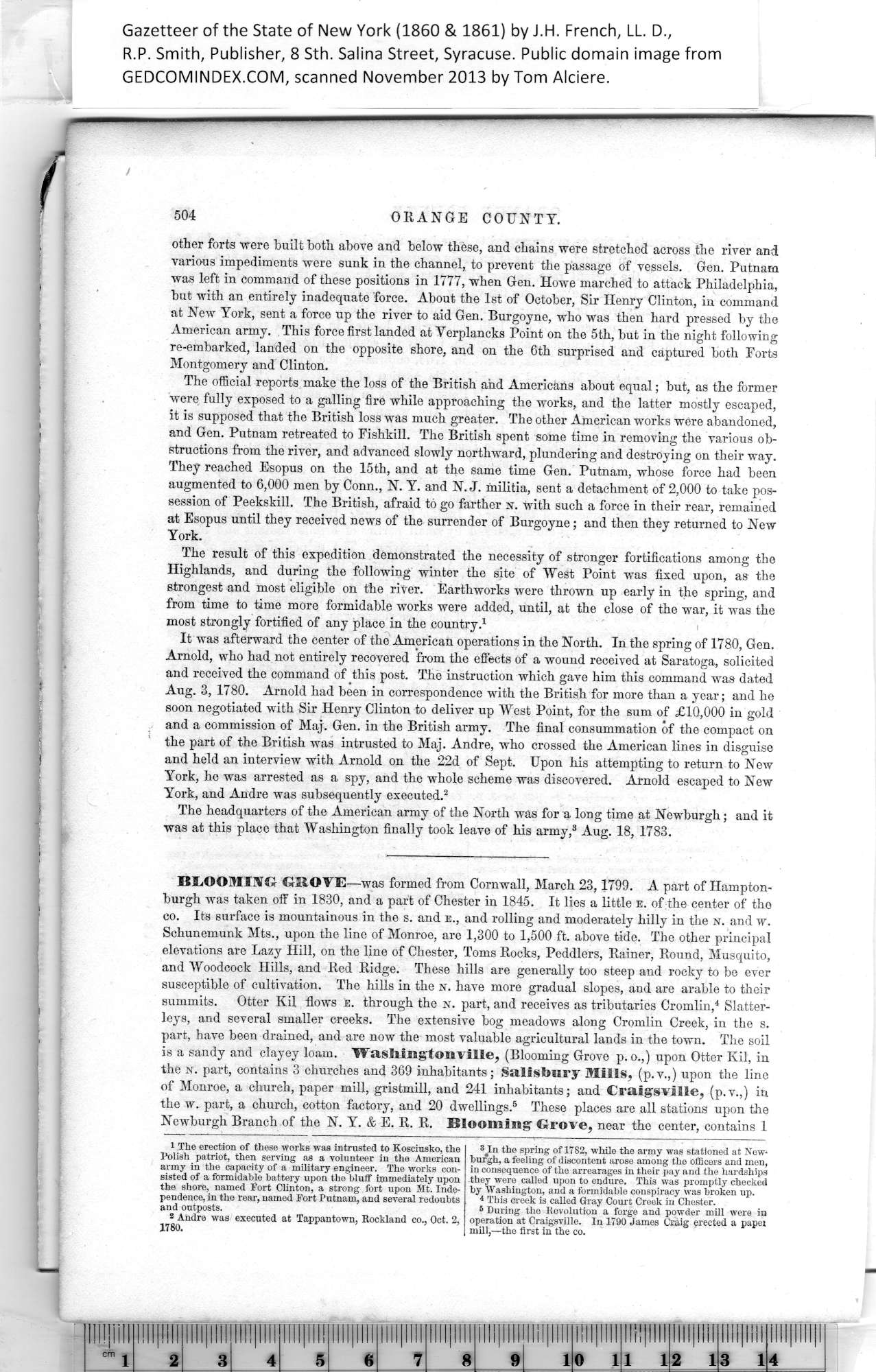|
504 ORANGE COUNTY.
other forts were built both above and below these, and chains were stretched across the river and
various impediments were sunk in the channel, to prevent the passage of vessels. Gen. Putnam
was left in command of these positions in 1777, when Gen. Howe marched to attack Philadelphia,
but with an entirely inadequate force. About the 1st of October, Sir Henry Clinton, in command
at New York, sent a force up the river to aid Gen. Burgoyne, who was then hard pressed by the
American army. This force first landed at Yerplancks Point on tbe 5th, but in the night following
re-embarked, landed on the opposite shore, and on the 6th surprised and captured both Forts
Montgomery and Clinton.
The official reports make the loss of the British and Americans about equal; hut, as the former
were fully exposed to a galling fire while approaching the works, and the latter mostly escaped,
it is supposed that the British loss was much greater. The other American works were abandoned,
and Gen. Putnam retreated to Fishkill. The British spent some time in removing the various ob¬
structions from the river, and advanced slowly northward, plundering and destroying on their way.
They reached Esopus on the 15th, and at the same time Gen. Putnam, whose force had been
augmented to 6,000 men hy Conn., N. Y. and N.J. militia, sent a detachment of 2,000 to take pos¬
session of Peekskill. The British, afraid to go farther n. with such a force in their rear, remained
at Esopus until they received news of the surrender of Burgoyne; and then they returned to New
York.
The result of this expedition demonstrated the necessity of stronger fortifications among the
Highlands, and during the following winter the site of West Point was fixed upon, as the
strongest and most eligible on the river. Earthworks were thrown up early in the spring, and
from time to time more formidable works were added, until, at the close of the war, it was the
most strongly fortified of any place in the country.1
It was afterward the center of the American operations in the North. In the spring of 1780, Gen.
Arnold, who had not entirely recovered from the effects of a wound received at Saratoga, solicited
and received the command of this post. The instruction which gave him this command was dated
Aug. 3, 1780. Arnold had been in correspondence with the British for more than a year; and he
soon negotiated with Sir Henry Clinton to deliver up West Point, for the sum of £10,000 in gold
and a commission of Maj. Gen. in the British army. The final consummation of the compact on
the part of the British was intrusted to Maj. Andre, who crossed the American lines in disguise
and held an interview with Arnold on the 22d of Sept. Upon his attempting to return to New
York, he was arrested as a spy, and the whole scheme was discovered. Arnold escaped to New
York, and Andre was subsequently executed.2
The headquarters of the American army of the North was for a long time at Newburgh; and it
was at this place that Washington finally took leave of his army,3 Aug. 18, 1783.
BLOOMING GBOVE—was formed from Cornwall, March 23,1799. A part of Hampton-
hurgh was taken off in 1830, and a part of Chester in 1845. It lies a little e. of the center of tho
co. Its surface is mountainous in the s. and e., and rolling and moderately hilly in the n. and w.
Schunemunk Mts., upon the line of Monroe, are 1,300 to 1,500 ft. ahove tide. The other principal
elevations are Lazy Hill, on the line of Chester, Toms Rocks, Peddlers, Rainer, Round, Musquito,
and Woodcock Hills, and Red Ridge. These hills are generally too steep and rocky to be ever
susceptible of cultivation. The hills in the n. have more gradual slopes, and are arable to their
summits. Otter Kil flows E. through the n. part, and receives as tributaries Cromlin,2 Slatter-
leys, and several smaller creeks. The extensive hog meadows along Cromlin Creek, in the s.
part, have been drained, and are now the most valuable agricultural lands in the town. The soil
is a sandy and clayey loam. Washiligtoiiville, (Blooming Grove p.o.,) upon Otter Kil, in
the n. part, contains 3 churches and 369 inhabitants; Salisbury Mills, (p.v.,) upon the line
of Monroe, a church, paper mill, gristmill, and 241 inhabitants; and Craig'sville, (p.v.,) in
the w. part, a church, cotton factory, and 20 dwellings.3 These places are all stations upon the
Newburgh Branch of the N. Y. & E. R. R. Blooming Grove, near the center, contains 1
|
8#In the spring of 1782, while the army was stationed at New¬
burgh, a feeling of discontent arose among the officers and men,
in consequence of the arrearages in their pay and the hardships
they were called upon to endure. This was promptly cheeked
by Washington, and a formidable conspiracy was broken up.
4 This creek is called Gray Court Creek in Chester.
6 During the Revolution a forge and powder mill were in
operation at Craigsville. In 1790 James Craig erected a paper
mill,—the first in the co. |
1
The erection of these Works was intrusted to Kosciusko, the
2
sisted of a formidable battery upon the bluff immediately upon
3
the shore, named Fort Clinton, a strong fort upon Mt. Inde¬
|
